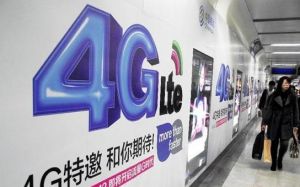Difference between revisions of "4G"
imported>Ciic |
imported>Ciic |
||
| Line 1: | Line 1: | ||
| − | [[Image: | + | [[Image:4G.JPEG|thumb|300px]] |
'''4G''' ('''第四代移动通信技术''') is the fourth generation of mobile communications technology featuring the 3G and WLAN technologies that enable transmission of high-quality video images as displayed in a high-definition television. | '''4G''' ('''第四代移动通信技术''') is the fourth generation of mobile communications technology featuring the 3G and WLAN technologies that enable transmission of high-quality video images as displayed in a high-definition television. | ||
Revision as of 08:44, 5 December 2013
4G (第四代移动通信技术) is the fourth generation of mobile communications technology featuring the 3G and WLAN technologies that enable transmission of high-quality video images as displayed in a high-definition television.
The 4G system supports download speeds of up to 100Mbps - roughly 2000 times faster than that on the current dial-up networking – and upload speeds of 20 Mbps, fulfilling nearly all the needs of users towards wireless services.
Moreover, the 4G network can be deployed in the places where the DSL and cable modems are not covered and can be then extended to the whole region.
Conceivable applications include amended mobile web access, IP telephony, gaming services, high-definition mobile TV, video conferencing, 3D television, and cloud computing.
Contents
4G license in China
On December 4, 2013, the Ministry of Industry and Information Technology (MIIT) issued 4G licenses to three Chinese telecom operators to provide users 20 to 50 times faster mobile Internet access compared with the current 3G network and create a new trillion-yuan market for device and service upgrade, marking the beginning of a new era in China's high-speed mobile network.
China Mobile, China Telecom and China Unicom received permits to offer fourth-generation (4G) mobile network services employing homegrown TD-LTE technology.
The ministry did not issue the more international FDD-LTE license this time, but said will test the converged TD-LTE/LTE FDD network in the future.
The 4G technology will lower bandwidth costs and promise faster mobile broadband. Users in Beijing, Guangzhou and Chongqing will be the first to enjoy commercial 4G services. Shanghai, which is still building a citywide 4G network, will launch the services later. China Mobile said the rates for 4G services will be cheaper than those for 3G. In some cities where the company has launched the 4G network for trial commercial use, the tariff is 20 percent less than similar 3G network plans.
Li Yue, president of China Mobile, said the price of 4G smartphones will go down quickly following the approval of the 4G network for commercial use.
Now only a number of smartphone models in China are equipped with modules that support home-grown 4G TD-LTE technology, with their prices ranging from 350 U.S. dollars to 800 U.S. dollars.
China is the major promoter of the TD-LTE standard and is also a major owner of the standard's core patents. LTE FDD is the other international 4G standard and is popular in Europe.
The MIIT said the convergence of the two standards is gaining momentum in the global telecom industry. A total of 10 converged TD-LTE/LTE FDD commercial networks have been established so far worldwide.
Two 4G candidate systems are commercially deployed: the Mobile WiMAX standard (first used in South Korea in 2006), and the first-release Long Term Evolution (LTE) standard (in Oslo, Norway and Stockholm, Sweden since 2009). It has however been debated if these first-release versions should be considered to be 4G or not, as discussed in the technical definition section below.
4G standards
LTE
Long Term Evolution (LTE) technology is the evolution of the 3G technology. It improves the radio interface and introduces OFDM and MIMO as the only standard of its wireless networking evolution. LTE has a theoretical net bit rate capacity of up to 100 Mbit/s in the downlink and 50 Mbit/s in the uplink if a 20 MHz channel is used — and more if multiple-input multiple-output (MIMO) are used.
LTE-Advanced
LTE Advanced (Long Term Evolution Advanced) is essentially an enhancement to LTE. It is not a new technology, but rather an improvement on the existing LTE network. This upgrade path makes it more cost effective for vendors to offer LTE and then upgrade to LTE Advanced which is similar to the upgrade from WCDMA to HSPA.
WiMax or IEEE 802.16
WiMax (Worldwide Interoperability for Microwave Access) or IEEE 802.16 is the earliest 4G standard that appeared around in 2000. It provides up to 70M of Internet access rate, which is 30 times of that provided by the 3G technology. Wimax has about 8 million users worldwide, with 60 percent in the U.S.
Wireless MAN-Advanced or IEEE 802.16m
Wireless MAN or IEEE 802.16m is the upgrade of WiMax under development, with the objective to fulfill the IMT-Advanced criteria of 1 Gbit/s for stationary reception and 100 Mbit/s for mobile reception.
International standards
On January 18, 2012, the International Telecommunications Union approved LTE-Advanced and WirelessMAN-Advanced (802.16m) technologies as the international 4G standards at the plenary meeting of Radio Communication Session of 2012 . China’s home-grown TD-LTE-Advanced and FDD-LTE-Advance become the international 4G standards thereby.
